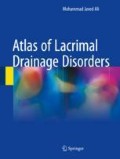Abstract
The advances in nuclear medicine have made dacryoscintigraphy a fairly safe and easy method for assessing the flow dynamics and other physiological aspects of lacrimal system [1–5]. It has a complementary role to anatomic studies and can be useful in evaluating pediatric epiphora, partial obstructions, and functional nasolacrimal duct obstructions. The test is performed by instilling 10 μl of technetium 99 pertechnetate into the conjunctival cul-de-sac and tracing the dye through the lacrimal system using a pinhole-collimated gamma camera. Patients are instructed to blink normally, and images are acquired in real time for up to 30 min. The study end point is the detection of radionuclide dye in the nasal cavity. In a typical normal DSG, visualization of canaliculi and sac occurs before 30 s and with passage into the nasal cavity in 10–20 min. Areas of interest can be marked on the DSG images, and quantity of tracer and times taken can be plotted on the time-activity scales. For example, if the system is obstructed at a point, the time-activity slope there would be flat. Disadvantages of DSG include poor anatomical details, poor resolution, and variable transit times throughout the lacrimal system [1–5].
References
Kousoubris PD. Radiological evaluation of lacrimal and orbital disease. In: Woog JJ, editor. Endoscopic lacrimal and orbital surgery. 1st ed. Oxford: Butterworth-Hienemann; 2004. p. 79–104.
Lefebvre DR, Freitag SR. Update on imaging of the lacrimal drainage system. Surv Ophthalmol. 2012;27:175–86.
Rossomondo RM, Carlton WH, Trueblood JH, et al. A new method of evaluating lacrimal drainage. Arch Ophthalmol. 1972;88:523–5.
Hurwitz JJ, Maisey MN, Welham RAN. Quantitative lacrimal scintillography. Br J Ophthalmol. 1975;59:313–22.
Sagili S, Selva D, Malhotra R. Lacrimal scintigraphy: interpretation more art than science. Orbit. 2012;31:77–85.
Author information
Authors and Affiliations
Rights and permissions
Copyright information
© 2018 Springer Nature Singapore Pte Ltd.
About this chapter
Cite this chapter
Ali, M.J. (2018). Dacryoscintigraphy. In: Atlas of Lacrimal Drainage Disorders. Springer, Singapore. https://doi.org/10.1007/978-981-10-5616-1_11
Download citation
DOI: https://doi.org/10.1007/978-981-10-5616-1_11
Published:
Publisher Name: Springer, Singapore
Print ISBN: 978-981-10-5615-4
Online ISBN: 978-981-10-5616-1
eBook Packages: MedicineMedicine (R0)

